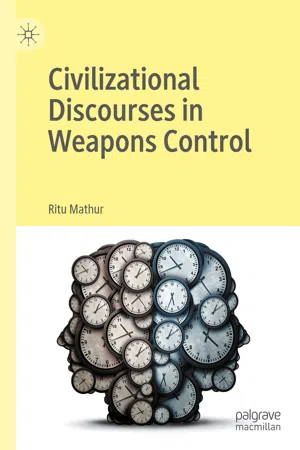Doomsday Clock
How do we think of time in practices of
weapons control? What is the significance of time in reimagining and rewriting a
postcolonial history of
arms control and
disarmament? What are the possibilities and limits of a
postcolonial intervention in addressing the problem of weapons? It is important to dwell on these questions as it appears as if the
violence of
Total War has silenced all
discourses on temporalizing
security and left as a
remnant of
war only a wish-image in the form of a Doomsday Clock, a wish image that helps calibrate the passage of time within the
discipline of
arms control and
disarmament. The horrifying wish
image of a
symbolic Doomsday Clock is representative of ‘both a mental and physical expression of ‘individual and
collective desires or (manipulation of those
desires)’ to avoid a
nuclear war.
1 A
remnant of
Total War, the Doomsday Clock is a wish
image circulating in the
collective consciousness in which the old and the new interpenetrate … in them the collective seeks both to overcome and to transfigure the immaturity of the social product and the inadequacies in the social organization of production … what emerges in these images is the resolute effort to distance oneself from all that is antiquated—which includes however the recent past.2
The Doomsday Clock is a wish-image in the field of security studies diligently calibrating the growing dangers of nuclear war and seeking to avoid a nuclear holocaust. Since its inception in 1947, the Doomsday Clock has been a ‘simple way of demonstrating the danger to Earth and humanity posed by nuclear war.’3
The Doomsday Clock as a wish-image occupies a special symbolic place in the collective consciousness of the security studies community.4 The seeds of this collective consciousness were sowed by nuclear scientists affiliated with the Manhattan Project concerned with the growing disregard for science and the unfolding dynamic of the Cold War and seeking to guide political leadership on the dangers and risks associated with nuclear weapons. Doomsday Clock conveys a ‘certain sense of historical time in everyday speech of public life in modern societies.’5 The movement of this clock is tenaciously reported by journalists and scholars since the end of the Second World War and the transition to a nuclear era. The movement of the hands of the Doomsday Clock is carefully noted by those fearful of a nuclear apocalypse and concerned with risks nuclear weapons pose to ‘global civilization.’6 This wish image ‘marks the site of ambivalence’ as it seeks to make ‘present something that is absent—and temporally deferred: it is the representation of a time that is elsewhere, a repetition.’7
In the last decade there have been several articles reporting not only a growing concern among scientists with regard to the possible threat of use of nuclear weapons but also a growing indifference and denial of science and the need for political leadership to affirm the primacy of science. This awareness is compounded with a growing acknowledgment that ‘historians of science and technology, sociologists of science, and political scientists interested in science and security issues rarely discuss each other’s work.’8 This lack of interdisciplinary dialogue and populist discourses have generated concerns with regard to ‘casual talk,’ ‘loose but dangerous rhetoric’ and the reluctance to ‘embrace science’ by statesmen engaged in making important decisions with regard to nuclear weapons.9 These concerns are compounded with a resurgence of discourses on the dangers of nuclear weapons proliferation and dubious predictions of an impending clash of civilizations between ‘The West and the Rest.’10 Questions are being raised whether we can ‘trust’ the Doomsday Clock and whether use of ‘hypothetical threats’ often leads to ‘proliferation of nuclear panic’ and ‘eventually they lose their capacity to make us afraid.’11 As the Doomsday Clock ticks forward hundred seconds to midnight, it might be pertinent to dwell on the dynamics of temporalizing security with regard to weapons regulation and prohibition.
Time and Civilization
Siba Grovogui insists, ‘Security politics must be construed against the backdrop of a possible apocalypse or the possibility of the end of time as the end of politics.’12 Andrew Hom describes ‘clock time’ or ‘modern time’ ‘associated with contemporary clocks and watches’ as ‘a form of reckoning based on the “continuous indication of equal hours” abstracted from celestial motions.’13 While ‘clock time’ is seen as deterministic, a ‘slaughter bench’ of empirical events, it can be easily subsumed by ‘calendar time’ which serves as a monument of historical consciousness, providing opportunities for remembrance and recreation ‘in which history is made rather than suffered.’14 It is possible to draw up a calendar tracing the history of the movement of the Doomsday Clock since its inception, but it is questionable whether such a limited exercise can help us ‘theorise international political time...
